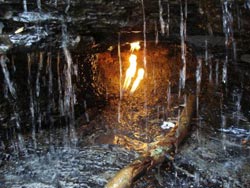Geologists Study Mystery of 'Eternal Flames'

Indiana University<br> <br>'Eternal flame' at New York's Chestnut Ridge County Park<br>
A little-known but spectacular flame in Erie County, N.Y., is the focus of an article in the journal Marine and Petroleum Geology, co-authored by Agnieszka Drobniak, research scientist with the Indiana Geological Survey, and Arndt Schimmelmann, senior scientist in the Department of Geological Sciences in the College of Arts and Sciences.
The article results from a U.S. Department of Energy research grant to Schimmelmann and Maria Mastalerz, senior scientist with the Indiana Geological Survey and graduate faculty member at the Department of Geological Sciences. The project seeks to identify natural gas seeps in Indiana and nearby states and assess their contributions to atmospheric concentrations of greenhouse gases.
The researchers said much remains to be learned about the passage of gas from underground rock layers to the Earth's surface — occasionally in “macro seeps” strong and abundant enough to produce a continuous flame like the one in western New York.
“The story is developing,” Schimmelmann said.
Giuseppe Etiope of the National Institute of Geophysics and Volcanology in Italy is lead author of the Marine and Petroleum Geology article, “Natural seepage of shale gas and the origin of 'eternal flames' in the Northern Appalachian Basin, USA.” Etiope, who has studied eternal flames around the world, said the New York flame, behind a waterfall in Chestnut Ridge Park, is the most beautiful he has seen.
Not only that, but it may feature the highest concentrations of ethane and propane of any known natural gas seep. Approximately 35 percent of the gas is ethane and propane, as opposed to methane, the dominant constituent in natural gas. Ethane and propane can be valuable byproducts in the processing of natural gas.
By analyzing the gases and comparing them with gas well records from the region, the researchers concluded the gas fueling the Chestnut Ridge Park flame originates from Rhinestreet Shale, an Upper Devonian formation about 400 meters deep. It reaches the surface through passages associated with faulting caused by tectonic activity.
At the New York site, the researchers identified numerous “micro seeps” of gas, apparently from the same source that fuels the eternal flame. This suggests that such seeps, if they are numerous and widespread, could make a significant contribution to atmospheric concentrations of greenhouse gases and other pollutants.
The researchers also studied a larger eternal flame at Cook Forest State Park in northwestern Pennsylvania. They determined that flame, in a continuously burning fire pit, is not a natural seep but a leak from an abandoned gas well. The source is thought to be a conventional gas reservoir, not shale.
Mastalerz said naturally occurring methane sources are believed to account for about 30 percent of the total methane emissions in the Earth's atmosphere. Natural gas seeps are thought to be the second most significant source of naturally occurring methane emissions, after wetlands.
But finding seeps is like searching for a needle in a haystack. Last year, the researchers surveyed a region of Kentucky that is geologically similar to western New York — and where “burning springs” figure in local history and folklore — but turned up no evidence of escaping natural gas.
Schimmelmann said researchers have found elevated levels of carbon dioxide in caves, possibly resulting from methane that is converted by microorganisms to carbon dioxide gas as it seeps slowly toward the surface. Carbon dioxide is also a greenhouse gas, but it is 20 times less effective at trapping heat than methane.
The findings suggest natural gas seeps occur in areas that have experienced tectonic activity, and it may be easier to find them in caves, which capture and concentrate gas when it reaches the surface. A next step in the research, planned for this summer, is to continue the search in areas of Pennsylvania, West Virginia and Virginia where gas-bearing shale underlies cave systems.
Funding for the research comes from the U.S. Department of Energy.
Media Contact
More Information:
http://www.iu.eduAll latest news from the category: Earth Sciences
Earth Sciences (also referred to as Geosciences), which deals with basic issues surrounding our planet, plays a vital role in the area of energy and raw materials supply.
Earth Sciences comprises subjects such as geology, geography, geological informatics, paleontology, mineralogy, petrography, crystallography, geophysics, geodesy, glaciology, cartography, photogrammetry, meteorology and seismology, early-warning systems, earthquake research and polar research.
Newest articles

Properties of new materials for microchips
… can now be measured well. Reseachers of Delft University of Technology demonstrated measuring performance properties of ultrathin silicon membranes. Making ever smaller and more powerful chips requires new ultrathin…

Floating solar’s potential
… to support sustainable development by addressing climate, water, and energy goals holistically. A new study published this week in Nature Energy raises the potential for floating solar photovoltaics (FPV)…

Skyrmions move at record speeds
… a step towards the computing of the future. An international research team led by scientists from the CNRS1 has discovered that the magnetic nanobubbles2 known as skyrmions can be…




















